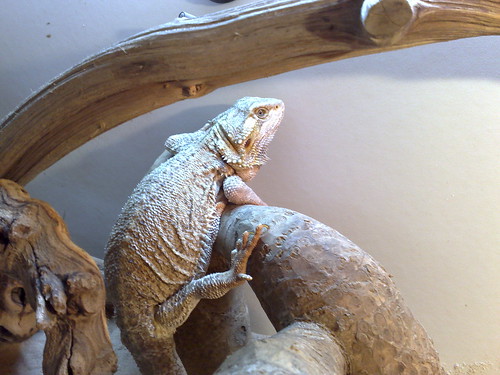A stuck shed on a bearded dragon can appear on the head, feet, belly, and tail. A common sign of a stuck shed is shriveling up at the tips of tails.
The stuck bits will look drier than the surrounding skin and might have lifted or ragged edges.
If your bearded dragon does not have enough rough surfaces to rub against, it may stop shedding prematurely.
The stuck shed can occur when a bearded dragon does not have enough nutrients. When pieces of skin don’t come off during shedding, it is called a “stuck shed”.
Let’s Talk About Bearded Dragon Shedding
Bearded dragons are reptiles that molt or shed their skin periodically.
This process is known as shedding and typically occurs every four to eight weeks depending on the age of the dragon.
During a shedding cycle, old skin gradually loosens and separates from the body, leaving behind new healthy skin underneath.
Shedding helps the bearded dragon maintain good health by allowing for growth and providing protection against infection.
Shedding can be identified in several ways.
As a beardie begins to shed, its scales may appear duller than usual and start to flake off easily when touched with a finger.
The eyes may have an opaque sheen while they shed due to fluid buildup under the eyelids caused by pressure from molting.
In addition, stuck sheds remain attached at certain points on the body and look like pieces of wrinkled fabric clinging onto the dragon’s body.
These areas require special attention so that no damage or irritation is done to the animal during removal.
Signs Of Normal Shedding
Shedding is an important part of the maturation process for these reptiles, and understanding the telltale signs can help reptile owners recognize when their pet needs assistance.
There are several clues to watch out for that indicate normal shedding in your bearded dragon.
The first sign of successful shedding is observing small pieces of skin or loose scales near where the beardie has been resting. This evidence may appear as tiny flakes around your pet’s eyes, legs, toes, tail, and sides.
Another indication a healthy shed has occurred is seeing dark patches forming on their skin before it begins peeling off; these darkened spots are commonly found along the spine and behind the head.
Additionally, an increase in basking time could be another indicator of successful shedding because this behavior helps loosen up the old skin so it can fall off more easily.
Lastly, if you notice any whitish material lined with pink between your pet’s toes or other areas that require frequent moistening during bathing times then they have probably just finished shedding.
By being aware of these common indicators such as discolored spots, flaky residue, and increased sunning behaviors you will be better equipped to understand when your dragon is going through a natural shed cycle without complications.
Causes Of Stuck Shed
Stuck shed is a condition caused by improperly maintained environmental factors.
Most commonly, stuck shed occurs when the shedding temperature and humidity levels of the bearded dragon enclosure are not properly regulated.
Other causes may include an improper diet, lack of water consumption, or inadequate lighting.
Here are four common causes of the stuck shed in bearded dragons:
- Shedding temperature that is too high or low
- Humidity levels that are too high or low
- Not enough water consumption throughout the day
- An unbalanced diet consisting mostly of insects
Treatment For Stuck Shed
Stuck shed is a common problem among bearded dragons and can be caused by several different factors.
The most common cause of stuck shed is poor humidity levels, but incorrect diet or too much handling may also contribute to the issue.
When it comes to treating stuck shed in bearded dragons, there are two main methods that should be considered.
The first method for dealing with stuck shed involves manually removing the remaining pieces of skin from the dragon’s body.
This process should only be done when absolutely necessary, as it can damage the delicate scales underneath if not performed properly.
To remove sticking sheds safely, use tweezers to slowly dislodge any visible pieces of skin without causing harm to the underlying tissue.
Use lukewarm water during this process, as hot water could further irritate the affected area.
The second treatment option for stuck shedding involves increasing the humidity around your bearded dragon’s enclosure and providing them with regular baths.
Increasing the humidity will help soften their skin so they can naturally complete their shedding cycle more easily; ideally, aim for 50-70% relative humidity inside their habitat at all times.
Bathing your dragon regularly has multiple benefits – it helps keep them hydrated, allows them to absorb vitamins through their skin, and encourages natural shedding behaviors.
Make sure you provide warm (not too hot) shallow baths twice weekly lasting approximately 10-15 minutes each time; never leave your pet unsupervised in a bathtub!
By following these steps, many cases of stuck shedding in beardies can be resolved quickly and safely; however, if symptoms persist after trying both treatments it may be advisable to contact an exotics vet for further advice on treating skin problems in reptiles.
Preventing Stuck Shed In The Future
In order to prevent stuck sheds in bearded dragons, it is important to understand the shedding habits and create an optimal environment.
Proper lighting, humidity levels, and moistening of the skin are all essential components of helping ensure that a dragon’s shedding process goes smoothly.
Lights should be kept on for 10-12 hours daily in order to replicate their natural desert habitat.
The temperature should also remain consistent at 80-90 degrees Fahrenheit with access to basking spots between 95-110 degrees depending upon age and size.
Humidity levels need to stay around 40%-50% as well.
Additionally, moisture can be added by lightly misting the tank or through baths multiple times per week.
This will help keep the skin hydrated which helps facilitate proper shedding.


